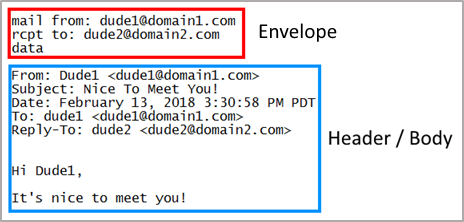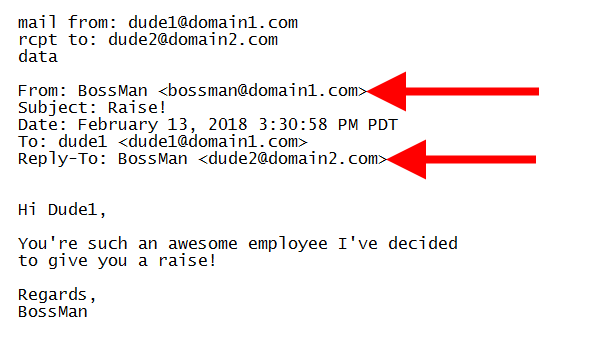According to Verizon, email fraud accounts for more than 90% of enterprise attacks. Why is email such a popular vector for spreading malware and malicious links? Because it’s much easier for criminals to convince a human to click on a fraudulent file or link within an email than it is to force their way into a hardened infrastructure.
Think about it this way: Would you rather take on a tank or trick the crew to come out of the tank and surrender? The latter option is much easier.
How Email Spoofing Works: The Structure of Email
Why can’t we just harden email like we do a firewall and turn it into a tank? Because email wasn’t built with security in mind. It was invented in the 1960’s and the original standard, RFC 822, was written in 1982. Updated standards weren’t written until 2008, which contain the current email structure that we all know and are comfortable with.
Email as we know it today consists of three major sections:
- The envelope
- The message header
- The message body
Each email program handles email differently, so they all speak a common language, Simple Mail Transport Protocol (SMTP), to allow these different systems to talk to each other.
In many ways, email is like a letter that we might mail. However, the recipient of the email doesn’t see the envelope. In most cases, that’s fine because when we compose an email in our email clients, the envelope information usually gets filled in from the header information automatically.
However, with email spoofing, a threat actor can put whatever he/she wants into the following fields:
- Mail from:
- From:
- Subject:
- Date:
- To:
- Reply-To:
Why are they allowed to do that and how does email spoofing work? Let’s explore an example.
How To Spoof an Email

The box in red above highlights the email’s envelope. Normally the envelope fields are filled out for the sender automatically during the translation of the header. Neither the sender nor the recipient usually sees this information. The stuff in blue is the header and body. This is the stuff you normally see when you open an email that was sent to you.
It is possible for the sender to tinker with the message header and spoof the sender’s identify so the email looks like it is from someone other than Dude1. Let’s break down how.
How To Identify a Spoofed Email
Say you have a friend that likes to play practical jokes on you. And you receive an email from them that says this:

Notice that the envelope fields are correct, but the From and Reply-To are false. When Dude1 receives this email, he may think it’s from his boss. When he hits “Reply” all he’ll see in the To: field is the “BossMan” name, but it will go back to his friend who spoofed the email, Dude2.
Cyber criminals can cleverly disguise an email in the same way and custom tailor it for their intended victims
For example, if a criminal wants banking credentials from his or her target, they can do the same thing Dude2 did, but instead of telling Dude1 that he got a raise, they can falsely represent themselves within the email as a trusted bank and direct the recipient to go to a fraudulent website.
How To Prevent Email Spoofing
Email fraud success relies on human vulnerability. There are many variations of this email scam, however at the core, they are the same: spoof the sender’s identity and use social engineering to convince the victim the email is not from a threat actor, but a legitimate source. From there, the end goal is usually the same, extracting money from the victim.
What’s the best way to protect yourself against email spoofing? Check out our Email Security Strategy Guide to find out.

